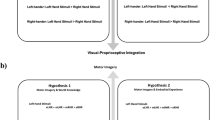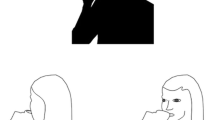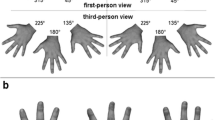Abstract
In a previous study, we found that when required to imagine another person performing an action, participants reported a higher correspondence between their own dominant hand and the hand used by the imagined person when the agent was visualized from the back compared to when the agent was visualized from the front. This suggests a greater involvement of motor representations in the back-view perspective, possibly indicating a greater proneness to put oneself in the agent’s shoes in such a condition. In order to assess whether bringing to the foreground the right or left hand of an imagined agent can foster the activation of the corresponding motor representations, we required 384 participants to imagine a person—as seen from the right or left side—performing a single manual action and to indicate the hand used by the imagined person during movement execution. The proportion of right- versus left-handed reported actions was higher in the right-view condition than in the left-view condition, suggesting that a lateral vantage point may activate the corresponding hand motor representations, which is in line with previous research indicating a link between the hemispheric specialization of one’s own body and the visual representation of others’ bodies. Moreover, in agreement with research on hand laterality judgments, the effect of vantage point was stronger for left-handers (who reported a higher proportion of right- than left-handed actions in the right-view condition and a slightly higher proportion of left- than right-handed actions in the left-view condition) than for right-handers (who reported a higher proportion of right- than left-handed actions in both view conditions), indicating that during the mental simulation of others’ actions, right-handers rely on sensorimotor processes more than left-handers, while left-handers rely on visual processes more than right-handers.
Similar content being viewed by others
References
Alaerts K, Heremans E, Swinnen SP, Wenderoth N (2009) How are observed actions mapped to the observer’s motor system? Influence of posture and perspective. Neuropsychologia 47:415–422
Arzy S, Thut G, Mohr C, Michel CM, Blanke O (2006) Neural basis of embodiment: distinct contributions of temporoparietal junction and extrastriate body area. J Neurosci 26:8074–8081
Aziz-Zadeh L, Maeda F, Zaidel E, Mazziotta J, Iacoboni M (2002) Lateralization in motor facilitation during action observation: a TMS study. Exp Brain Res 144:127–131
Aziz-Zadeh L, Iacoboni M, Zaidel E (2006) Hemispheric sensitivity to body stimuli in simple reaction time. Exp Brain Res 170:116–121
Bakan P, Putnam W (1974) Right-left discrimination and brain lateralization. Arch Neurol 30:334–335
Benton AL, Menefee FL (1957) Handedness and right-left discrimination. Child Dev 28:237–242
Brady N, Maguinness C, Ní Choisdealbha Á (2011) My hand or yours? Markedly different sensitivity to egocentric and allocentric views in the hand laterality task. PLoS One 6:e23316
Conson M, Aromino AR, Trojano L (2010) Whose hand is this? Handedness and visual perspective modulate self/other discrimination. Exp Brain Res 206:449–453
Conson M, Mazzarella E, Trojano L (2011) Self-touch affects motor imagery: a study on posture interference effect. Exp Brain Res 215:115–122
Conson M, Mazzarella E, Donnarumma C, Trojano L (2012) Judging hand laterality from my or your point of view: interactions between motor imagery and visual perspective. Neurosci Lett 530:35–40
Cooper K, Mohr C (2012) Former eating disorder impairs 3rd person but not 1st person perspective taking: does dance training help? Compr Psychol 1:7
Corballis MC, Beale IL (1970) Bilateral symmetry and behavior. Psychol Rev 77:451–464
Dassonville P, Zhu X-H, Ugurbil K, Kim S-G, Ashe J (1997) Functional activation in motor cortex reflects the direction and the degree of handedness. Proc Natl Acad Sci USA 94:14015–14018
de Lussanet MH, Fadiga L, Michels L, Seitz RJ, Kleiser R, Lappe M (2008) Interaction of visual hemifield and body view in biological motion perception. Eur J Neurosci 27:514–522
Dellatolas G, Viguier D, Deloche G, De Agostini M (1998) Right–left orientation and significance of systematic reversal in children. Cortex 34:659–679
Gardner M, Potts R (2010) Hand dominance influences the processing of observed bodies. Brain Cogn 73:35–40
Gehlbach H, Barge S (2012) Anchoring and adjusting in questionnaire responses. Basic Appl Soc Psychol 34:417–433
Gentilucci M, Daprati E, Gangitano M (1998) Right-handers and left-handers have different representations of their own hand. Cogn Brain Res 6:185–192
Gormley GJ, Dempster M, Best R (2008) Right-left discrimination among medical students: questionnaire and psychometric study. Brit Med J 337:a2826
Hannay HJ, Ciaccia PJ, Kerr JW, Barett D (1990) Self-report of right-left confusion in college men and women. Percept Mot Skill 70:451–457
Harris LJ, Gitterman SR (1978) Sex and handedness differences in well-educated adults’ self description of left-right confusability. Arch Neurol 35:773
Hommel B, Müsseler J, Aschersleben G, Prinz W (2001) The theory of event coding (TEC): a framework for perception and action. Behav Brain Sci 24:849–937
Ionta S, Blanke O (2009) Differential influence of hands posture on mental rotation of hands and feet in right and left handers. Exp Brain Res 195:207–217
Jackson PL, Meltzoff AN, Decety J (2006) Neural circuits involved in imitation and perspective-taking. NeuroImage 31:429–439
Jaspers-Fayer F, Peters M (2005) Hand preference, magical thinking and left-right confusion. Laterality 10:183–191
Jeannerod M (1994) The representing brain: neural correlates of motor intention and imagery. Behav Brain Sci 17:187–245
Jordan K, Wüstenberg T, Jaspers-Feyer F, Fellbrich A, Peters M (2006) Sex differences in left/right confusion. Cortex 42:69–78
Kaufman AS, Zalma R, Kaufman NL (1978) The relationship of right hand dominance to motor coordination, mental ability, and right-left advantages of young normal children. Child Dev 49:885–888
Knoblich G, Sebanz N (2006) The social nature of perception and action. Curr Dir Psychol Sci 15:99–104
Lewis JW, Phinney RE, Brefczynski-Lewis JA, DeYoe EA (2006) Lefties get it “right” when hearing tool sounds. J Cogn Neurosci 18:1314–1330
Lorey B, Bischoff M, Pilgramm S, Stark R, Munzert J, Zentgraf K (2009) The embodied nature of motor imagery: the influence of posture and perspective. Exp Brain Res 194:233–243
Maki RH, Grandy CA, Hauge G (1979) Why is telling right from left more difficult than telling above from below? J Exp Psychol Hum 5:52–67
Marzoli D, Mitaritonna A, Moretto F, Carluccio P, Tommasi L (2011a) The handedness of imagined bodies in action and the role of perspective-taking. Brain Cogn 75:51–59
Marzoli D, Palumbo R, Di Domenico A, Penolazzi B, Garganese P, Tommasi L (2011b) The relation between self-reported empathy and motor identification with imagined agents. PLoS One 6:e14595
Nì Choisdealbha Á, Brady N, Maguinness C (2011) Differing roles for the dominant and non-dominant hands in the hand laterality task. Exp Brain Res 211:73–85
Ofte SH (2002) Right–left discrimination: effects on handedness and educational background. Scand J Psychol 43:213–219
Parsons LM (1987) Imagined spatial transformations of one’s hands and feet. Cogn Psychol 19:178–241
Parsons LM (1994) Temporal and kinematic properties of motor behaviour reflected in mentally simulated action. J Exp Psychol Hum 20:709–730
Prinz W (1997) Perception and action planning. Eur J Cogn Psychol 9:129–154
Rigal R (1974) Hand efficiency and right-left discrimination. Percept Mot Skill 38:219–224
Rigal R (1994) Right–left orientation: development of correct use of right and left terms. Percept Mot Skill 79:1259–1278
Ruby P, Decety J (2001) Effect of subjective perspective taking during simulation of action: a PET investigation of agency. Nat Neurosci 4:546–550
Salmaso D, Longoni AM (1985) Problems in the assessment of hand preference. Cortex 21:533–549
Sirigu A, Duhamel JR (2001) Motor and visual imagery as two complementary but neurally dissociable mental processes. J Cogn Neurosci 13:910–919
Snyder TJ (1991) Self-rated right-left confusability and objectively measured right-left discrimination. Dev Neuropsychol 7:219–230
Solodkin A, Hlustik P, Noll DC, Small SL (2001) Lateralization of motor circuits and handedness during finger movements. Eur J Neurol 8:425–434
Stelzl I (2000) What sample sizes are needed to get correct significance levels for log-linear models? A Monte Carlo study using the SPSS procedure “Hiloglinear”. Methods Psychol Res Online 5:95–116
Stinear CM, Byblow WD, Steyvers M, Levin O, Swinnen SP (2006) Kinesthetic, but not visual, motor imagery modulates corticomotor excitability. Exp Brain Res 168:157–164
Storfer MD (1995) Problems in left-right discrimination in a high-IQ population. Percept Mot Skill 81:491–497
Tversky A, Kahneman D (1974) Judgment under uncertainty: heuristics and biases. Science 185:1124–1131
Vainio L, Mustonen T (2011) Mapping the identity of a viewed hand in the motor system: evidence from stimulus–response compatibility. J Exp Psychol Hum 37:207–221
Vingerhoets G, Sarrechia I (2009) Individual differences in degree of handedness and somesthetic asymmetry predict individual differences in left-right confusion. Behav Brain Res 204:212–216
Wakita M, Hiraishi H (2011) Effects of handedness and viewing perspective on Broca’s area activity. Neuroreport 22:331–336
Willems RM, Hagoort P (2009) Hand preference influences neural correlates of action observation. Brain Res 1269:90–104
Willems RM, Toni I, Hagoort P, Casasanto D (2009) Body-specific motor imagery of hand actions: neural evidence from right-and left-handers. Front Hum Neurosci 3:1–9
Willems RM, Hagoort P, Casasanto D (2010) Body-specific representations of action verbs: neural evidence from right- and left-handers. Psychol Sci 21:67–74
Conflict of interest
The authors declare that they have no conflict of interest.
Author information
Authors and Affiliations
Corresponding author
Electronic supplementary material
Below is the link to the electronic supplementary material.
221_2013_3587_MOESM1_ESM.pdf
Online Resource 1. The table shows the number of “Right hand” and “Left hand” responses according to participant’s sex, imagined agent’s sex, mapping modality, viewing perspective, participant’s handedness, participant’s handedness consistency, imagined agent’s handedness and imagined action. (PDF 310 kb)
Rights and permissions
About this article
Cite this article
Marzoli, D., Menditto, S., Lucafò, C. et al. Imagining others’ handedness: visual and motor processes in the attribution of the dominant hand to an imagined agent. Exp Brain Res 229, 37–46 (2013). https://doi.org/10.1007/s00221-013-3587-0
Received:
Accepted:
Published:
Issue Date:
DOI: https://doi.org/10.1007/s00221-013-3587-0




